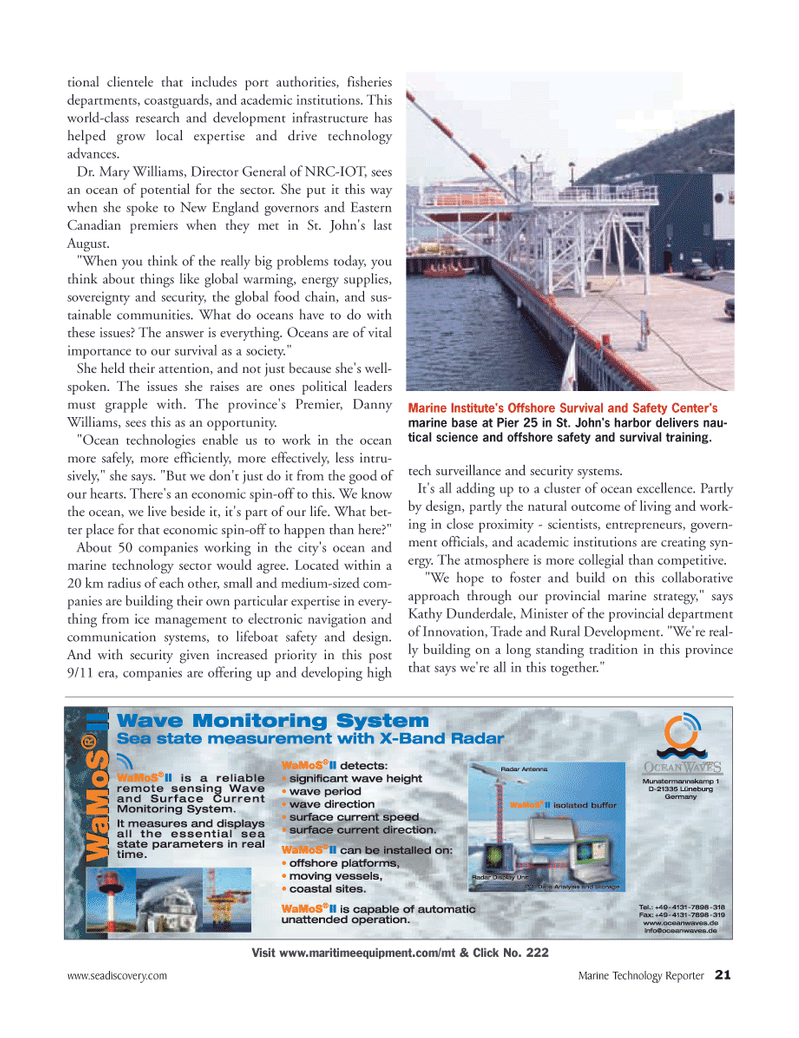
Page 20: of Marine Technology Magazine (March 2006)
AUVs; ROVs; UUVs
Read this page in Pdf, Flash or Html5 edition of March 2006 Marine Technology Magazine
www.seadiscovery.com Marine Technology Reporter 21 tional clientele that includes port authorities, fisheries departments, coastguards, and academic institutions. This world-class research and development infrastructure has helped grow local expertise and drive technology advances.
Dr. Mary Williams, Director General of NRC-IOT, sees an ocean of potential for the sector. She put it this way when she spoke to New England governors and Eastern
Canadian premiers when they met in St. John's last
August. "When you think of the really big problems today, you think about things like global warming, energy supplies, sovereignty and security, the global food chain, and sus- tainable communities. What do oceans have to do with these issues? The answer is everything. Oceans are of vital importance to our survival as a society."
She held their attention, and not just because she's well- spoken. The issues she raises are ones political leaders must grapple with. The province's Premier, Danny
Williams, sees this as an opportunity. "Ocean technologies enable us to work in the ocean more safely, more efficiently, more effectively, less intru- sively," she says. "But we don't just do it from the good of our hearts. There's an economic spin-off to this. We know the ocean, we live beside it, it's part of our life. What bet- ter place for that economic spin-off to happen than here?"
About 50 companies working in the city's ocean and marine technology sector would agree. Located within a 20 km radius of each other, small and medium-sized com- panies are building their own particular expertise in every- thing from ice management to electronic navigation and communication systems, to lifeboat safety and design.
And with security given increased priority in this post 9/11 era, companies are offering up and developing high tech surveillance and security systems.
It's all adding up to a cluster of ocean excellence. Partly by design, partly the natural outcome of living and work- ing in close proximity - scientists, entrepreneurs, govern- ment officials, and academic institutions are creating syn- ergy. The atmosphere is more collegial than competitive. "We hope to foster and build on this collaborative approach through our provincial marine strategy," says
Kathy Dunderdale, Minister of the provincial department of Innovation, Trade and Rural Development. "We're real- ly building on a long standing tradition in this province that says we're all in this together."
Visit www.maritimeequipment.com/mt & Click No. 222
Marine Institute's Offshore Survival and Safety Center's marine base at Pier 25 in St. John's harbor delivers nau- tical science and offshore safety and survival training.
MTR#2 (17-32).qxd 2/23/2006 5:01 PM Page 21

 19
19

 21
21
